 When it comes to talking about football matches, one of the most overlooked factors is the ball itself. We talk about the state of the pitch, the officials who take charge of the game and the form of the players, but very little thought is given to one of the most crucial bits of equipment involved in the whole process.
When it comes to talking about football matches, one of the most overlooked factors is the ball itself. We talk about the state of the pitch, the officials who take charge of the game and the form of the players, but very little thought is given to one of the most crucial bits of equipment involved in the whole process.
To some extent that’s because it’s such a simple thing; a round ball filled with air that you can buy in any decent sports shop around the world. Yet the truth is that the humble football has undergone many changes over the years and youth teams play with one that is a different size to the senior teams.
How, then, has the football developed over the years? There was a point, right back at the beginning of the sport, when rugby and football were very closely related. In fact, at the very start of things all that differentiated them were the two sets of rules that the players abided by. Rugby, as we know, is played with an oval shaped ball, whilst footballs are completely spherical. What happened to mean that footballs went in one direction and rugby balls went in another? Is the size of the ball itself all that important? How did we move from the original balls that football was played with through to the ultra-modern balls that we know and love today?
We’ll try to answer some of these questions and more on this page.
Early Footballs – Pig Bladder to Inner Tubes
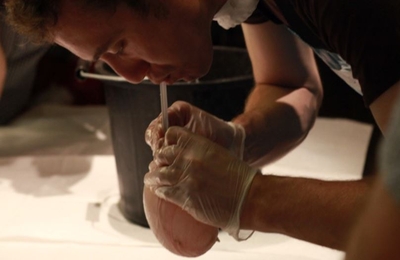
In the introduction we talked about the fact that football and rugby were initially very closely related sports, with the main thing that differed between them being the rules. That is especially true when we come to look at the balls that each sport was played with. It seems bizarre to think about nowadays, but originally both rugby balls and footballs were more round in appearance than anything else. That was because they were made from pig’s bladders, giving them a somewhat distinctive plum-like shape.
Part of the problem in those early days was that not all pigs were the same size or shape and, as a consequence, not all pig’s bladders were the same either. Sometimes they would be bigger than others, sometimes they would be strange shapes. The type of bladder you got would dictate how it reacted when it was kicked, thrown or otherwise used. It wasn’t until the introduction of rubber inner-tubes by Richard Lindon in 1862 that a definitive difference between footballs and rugby balls began to emerge.
It is believed that Lindon came up with the idea of using India rubber to make the ball after his wife, who had been helping him to blow up the pigs bladders into balls, passed away, likely from a disease she caught from one of the bladders. India rubber was far too difficult to blow up by mouth, so Lindon also invented the first known ball pump. The initial balls were far more spherical in appearance, but that didn’t go down too well with Rugby School who wanted to keep playing with a more oval-shaped ball in order to differentiate their game from the one being introduced up and down the country. At first these new rugby balls were egg-shaped, but in 1892 the Rugby Football Union decided to make oval the official shape of the rugby ball.
First Official Rules On Football Shape and Size
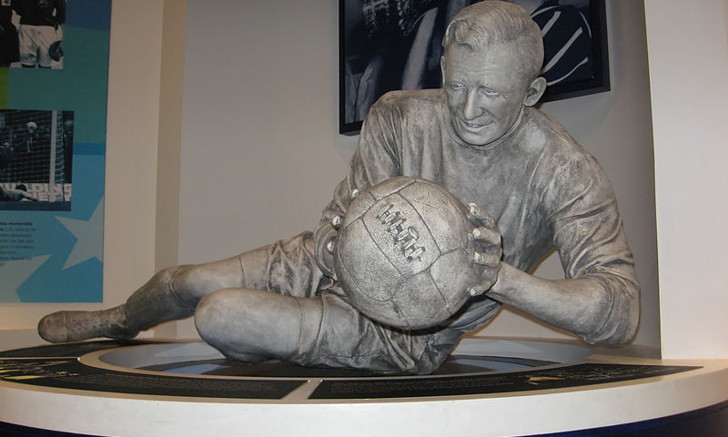
The Football Association was formed in 1863, but when it came up with a list of rules of the game no specification was put down regarding the size and shape of the ball that should be used for matches. It wasn’t until the rules were revised in 1872 that that changed and an official set of dimensions for the ball to be used was written down for the first time.
Today’s rules state that it must meet the following requirements:
- Be spherical
- Have a circumference of between 27 and 28 inches (68.6cm to 71.1cm)
- Be made of leather or other suitable material
- Weigh no less than 410g (14oz) and no more than 450g (16oz) at the start of the match
- Have a pressure equal to 0.6 – 1.1 atmosphere (600 – 1100 g/cm 2 ) at sea level (8.5 lbs/sq in to 15.6 lbs/sq in)
Believe it or not, those rules are very close to the original ones laid down in the nineteenth century, with the only major difference from the original rules to the current ones being the weight (it was increased from 13-15oz to 14-16oz).
Obviously one of the other key things that differs today to in the past is the material that balls are made from, with modern technology ensuring that the developments have been very much for the better. When Mitre started mass-producing balls in 1888, they believed that one of the most important qualities was that the ball could keep its shape. Because of that very thick and heavy leather was used, with cow’s rump making the best balls and cow’s shoulder making the cheaper ones.
Developing The Design – Leather & Stitches
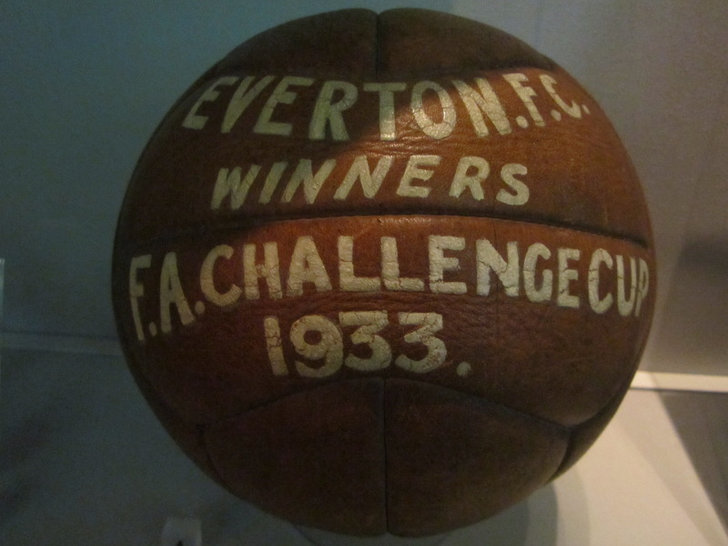
By the start of the twentieth century, the inner bladders of the balls were made with a strong rubber that could withstand a lot of pressure. The outside of the ball was made up of leather that was formed of eighteen sections. These were six panels with three strips on each panel, all brought together by stitching on one side of the ball. Invariably the leather was dyed dark brown, not for any real reason other than uniformity. The ball might have been good for kicking, but the stitching as well as the fact that the leather would absorb water meant that they were very uncomfortable to head!
One little known fact about the importance of the football involves the World Cup final of 1930. Argentina were playing Uruguay and no consensus could be reached regarding which country’s ball design to use. In order to make things as fair as possible, the Argentinian ball was used for the first-half and the Uruguayan one was used in the second-half. Argentina were 2-1 up at half-time, only for Uruguay to run out 4-2 winners by the end of the game. Would the result have been different had the Argentinian ball been used for the full ninety minutes? We’ll never know, but certainly this offer some circumstantial evidence about the idea that the design could have decided the outcome of the final.
In the wake of the Second World War, material began to be used in between the outer leather facade and the bladder inside. Obviously this offered a degree of cushioning and also ensured that the ball could maintain its shape easier. By the time the 1950s came around the colour of the ball from the spectator’s point of view began to be taken into account. Initially this was because of the introduction of floodlights, with a decision taken to white-wash the leather in order to allow the ball to be more visible from the crowd. Then, when it snowed, an orange ball was used for the first time.
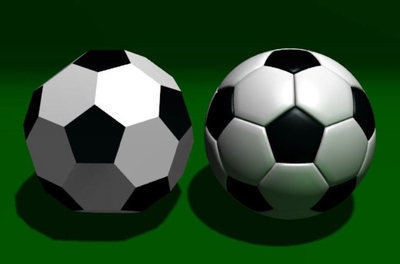 Interestingly, lessons weren’t really learnt from the match between Argentina and Uruguay in 1930. Different countries tended to play with differently sized balls, causing all sorts of problems when it came to international football matches. Believe it or not, though, FIFA didn’t actually introduce a proper Quality Programme for Footballs until 1996. The balls themselves underwent numerous developments before that, of course. Not least of which was the introduction of the ‘Buckminster’ ball. Developed by Richard Buckminster Fuller, the ‘Bucky’ consisted of 20 hexagonal and twelve pentagonal surfaces, sewn together to create a near perfect sphere.
Interestingly, lessons weren’t really learnt from the match between Argentina and Uruguay in 1930. Different countries tended to play with differently sized balls, causing all sorts of problems when it came to international football matches. Believe it or not, though, FIFA didn’t actually introduce a proper Quality Programme for Footballs until 1996. The balls themselves underwent numerous developments before that, of course. Not least of which was the introduction of the ‘Buckminster’ ball. Developed by Richard Buckminster Fuller, the ‘Bucky’ consisted of 20 hexagonal and twelve pentagonal surfaces, sewn together to create a near perfect sphere.
This new type of ball was officially used for the first time at the 1970 World Cup in Mexico, when an Adidas Telstar ball was introduced. It was also the first ball to feature alternating white and black panels, with the hope being that the darker colour would allow players to see any swerve taking affect on the ball. It wasn’t until the World Cup in Spain in 1982 that rubber was inlaid over the seems in an attempt to stop water seeping into the balls. Four years later, when the tournament returned to Mexico, polyurethane balls were used for the first time.
The Modern Football
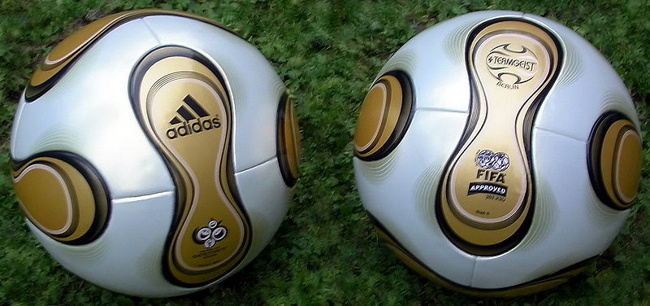
As incredible as it is to think about now, the first football with a colour other than black and white wasn’t used in an official tournament until the World Cup was held in France in 1998. Blue replaced black as the secondary colour, with a small amount of red also added in order to ensure that the tricolore of red, white and blue was present. When the tournament was held in Japan and Korea in 2002, any pretence of holding on to the traditional colours was abandoned in favour of a golden-coloured ball that began a complete shift in the way that balls were designed.
The first major shift in the design of the ball rather than the colouring of it came about in 2006, when Adidas introduced the Teamgeist.
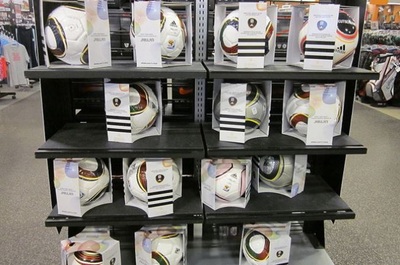
This ball had fourteen panels rather than the traditional thirty-two, meaning that more control was given to the players and that the ball was closer to be completely spherical than ever before. The panels were also moulded together rather than stitched, a design process that would be continued with the Jabulani ball that was used in South Africa in 2010. That featured just eight panels and was one of the most controversial balls in World Cup history.
Nevertheless, from the moment that the first synthetic balls were introduced in the 1960s and synthetic leather completely replace regular leather in the 1980s, the way football is played changed in its entirety. The design of footballs continues to change and develop, with the delicate balance between a ball that is light but firm, spherical and with an easily predicted flight-path a difficult one to find. A journey that’s ranged from pig’s bladders to synthetic leather, via India rubber and vulcanised rubber, isn’t one that’s going to end any time soon.
Designers will continue to find ways to make the balls the most important but under-appreciated part of the game.
Does The Size Of The Football Matter?
 One of the questions posed in the introduction but not yet answered is regarding the size of a football.
One of the questions posed in the introduction but not yet answered is regarding the size of a football.
Professional leagues around the world use a Size 5 ball, the measurements of which we told you about earlier. That is also the size of the ball used in the World Cup and other major tournaments.
In essence, the Size 5 is the ball that should be used for those playing proper football who are aged fourteen and up.
Depending on both the age of the player and the variation of the game that they’re playing, however, there are numerous different balls that can be used.
Age Difference
Here’s a look at the recommended size of football depending on the age of the user:
| Age | Ball Size |
|---|---|
| All Ages | 1 (Mini ball) |
| 3-6 | 2 (Midi ball) |
| 6-9 | 3 |
| 9-14 | 4 |
| 14+ | 5 |
Type Of Game Being Played

It would be easy to think that the age range is all that matters, but that wouldn’t be true.
The different type of football being played also dictates some information about the ball.
Here’s a little look at each and the information that you need to know:
Five-A-Side
Typically, five-a-side games are played with a standard football if the game is taking place outdoors. It’s only when the game moves indoors that the ball changes…
Indoor Football
Balls used for playing indoors are typically covered in a light felt in order to protect them from the rougher floor and walls that they’ll be kicked against. They’re also typically a little bit less bouncy than a regular football, allowing for closer control in the tight quarters. They’re still Size 5, though.
Training Balls
Also Size 5, training balls tend to be made from slightly more durable material than balls used for official matches. This is because they’re likely to be used in different environments and ‘put through their paces’ much more.
Futsal Balls
Futsal was created in 1930 in Montevideo, Uruguay. Often translated simply as ‘indoor football’, futebol de salão, to give it its full name, is more accurately described as being ‘hall football’. It is played with a Size 4 ball but the material used to make it is different.
Because it’s played on a hard surface and is a game of skill and close control, futsal balls often contain foam to make them less bouncy.
Beach Soccer Balls
Played on sand, beach soccer balls are Size 5 when it comes to their circumference, yet they’re typically slightly lighter than proper footballs. They usually range from between 14 to 15.5 ounces and use a softer leather casing that is more comfortable for bare feet.
